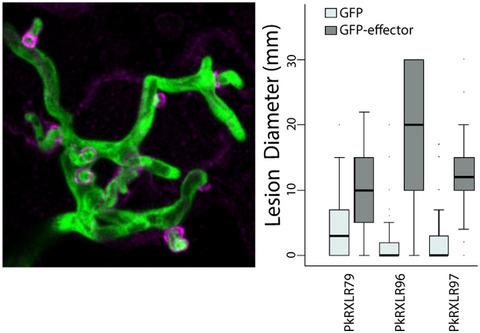当前位置:
X-MOL 学术
›
Mol. Plant Pathol.
›
论文详情
Our official English website, www.x-mol.net, welcomes your
feedback! (Note: you will need to create a separate account there.)
Haustorium formation and a distinct biotrophic transcriptome characterize infection of Nicotiana benthamiana by the tree pathogen Phytophthora kernoviae
Molecular Plant Pathology ( IF 4.8 ) Pub Date : 2021-05-20 , DOI: 10.1111/mpp.13072 Shumei Wang 1 , Ramesh R Vetukuri 2 , Sandeep K Kushwaha 2, 3 , Pete E Hedley 4 , Jenny Morris 4 , David J Studholme 5 , Lydia R J Welsh 4 , Petra C Boevink 4 , Paul R J Birch 1, 4 , Stephen C Whisson 4
Molecular Plant Pathology ( IF 4.8 ) Pub Date : 2021-05-20 , DOI: 10.1111/mpp.13072 Shumei Wang 1 , Ramesh R Vetukuri 2 , Sandeep K Kushwaha 2, 3 , Pete E Hedley 4 , Jenny Morris 4 , David J Studholme 5 , Lydia R J Welsh 4 , Petra C Boevink 4 , Paul R J Birch 1, 4 , Stephen C Whisson 4
Affiliation

|
Phytophthora species cause some of the most serious diseases of trees and threaten forests in many parts of the world. Despite the generation of genome sequence assemblies for over 10 tree-pathogenic Phytophthora species and improved detection methods, there are many gaps in our knowledge of how these pathogens interact with their hosts. To facilitate cell biology studies of the infection cycle we examined whether the tree pathogen Phytophthora kernoviae could infect the model plant Nicotiana benthamiana. We transformed P. kernoviae to express green fluorescent protein (GFP) and demonstrated that it forms haustoria within infected N. benthamiana cells. Haustoria were also formed in infected cells of natural hosts, Rhododendron ponticum and European beech (Fagus sylvatica). We analysed the transcriptome of P. kernoviae in cultured mycelia, spores, and during infection of N. benthamiana, and detected 12,559 transcripts. Of these, 1,052 were predicted to encode secreted proteins, some of which may function as effectors to facilitate disease development. From these, we identified 87 expressed candidate RXLR (Arg-any amino acid-Leu-Arg) effectors. We transiently expressed 12 of these as GFP fusions in N. benthamiana leaves and demonstrated that nine significantly enhanced P. kernoviae disease progression and diversely localized to the cytoplasm, nucleus, nucleolus, and plasma membrane. Our results show that N. benthamiana can be used as a model host plant for studying this tree pathogen, and that the interaction likely involves suppression of host immune responses by RXLR effectors. These results establish a platform to expand the understanding of Phytophthora tree diseases.
中文翻译:

吸器的形成和独特的生物营养转录组是树病原体 kernoviae 感染本氏烟草的特征
疫霉属物种会引起一些最严重的树木疾病,并威胁世界许多地区的森林。尽管已经生成了 10 多种树木致病疫霉属物种的基因组序列组合并改进了检测方法,但我们对这些病原体如何与其宿主相互作用的了解仍存在许多空白。为了促进感染周期的细胞生物学研究,我们检查了树病原体Phytophthora kernoviae是否可以感染模型植物Nicotiana Benthamiana 。我们转化P. kernoviae以表达绿色荧光蛋白 (GFP),并证明它在受感染的N. Benthamiana细胞内形成吸器。吸器也在天然宿主杜鹃花和欧洲山毛榉( Fagus sylvatica )的感染细胞中形成。我们分析了P. kernoviae在培养的菌丝体、孢子和本塞姆氏烟草感染过程中的转录组,检测到 12,559 个转录本。其中,1,052 个被预测编码分泌蛋白,其中一些可能充当促进疾病发展的效应子。从这些中,我们鉴定了 87 个表达的候选 RXLR(精氨酸-任意氨基酸-亮氨酸-精氨酸)效应子。我们在N. Benthamiana叶子中短暂表达了其中 12 个 GFP 融合体,并证明其中 9 个显着增强了P. kernoviae疾病的进展,并且不同程度地定位于细胞质、细胞核、核仁和质膜。我们的结果表明, N.Benthamiana 可用作研究这种树病原体的模型宿主植物,并且这种相互作用可能涉及 RXLR 效应子抑制宿主免疫反应。这些结果建立了一个平台来扩大对疫霉树病害的了解。
更新日期:2021-07-22
中文翻译:

吸器的形成和独特的生物营养转录组是树病原体 kernoviae 感染本氏烟草的特征
疫霉属物种会引起一些最严重的树木疾病,并威胁世界许多地区的森林。尽管已经生成了 10 多种树木致病疫霉属物种的基因组序列组合并改进了检测方法,但我们对这些病原体如何与其宿主相互作用的了解仍存在许多空白。为了促进感染周期的细胞生物学研究,我们检查了树病原体Phytophthora kernoviae是否可以感染模型植物Nicotiana Benthamiana 。我们转化P. kernoviae以表达绿色荧光蛋白 (GFP),并证明它在受感染的N. Benthamiana细胞内形成吸器。吸器也在天然宿主杜鹃花和欧洲山毛榉( Fagus sylvatica )的感染细胞中形成。我们分析了P. kernoviae在培养的菌丝体、孢子和本塞姆氏烟草感染过程中的转录组,检测到 12,559 个转录本。其中,1,052 个被预测编码分泌蛋白,其中一些可能充当促进疾病发展的效应子。从这些中,我们鉴定了 87 个表达的候选 RXLR(精氨酸-任意氨基酸-亮氨酸-精氨酸)效应子。我们在N. Benthamiana叶子中短暂表达了其中 12 个 GFP 融合体,并证明其中 9 个显着增强了P. kernoviae疾病的进展,并且不同程度地定位于细胞质、细胞核、核仁和质膜。我们的结果表明, N.Benthamiana 可用作研究这种树病原体的模型宿主植物,并且这种相互作用可能涉及 RXLR 效应子抑制宿主免疫反应。这些结果建立了一个平台来扩大对疫霉树病害的了解。











































 京公网安备 11010802027423号
京公网安备 11010802027423号